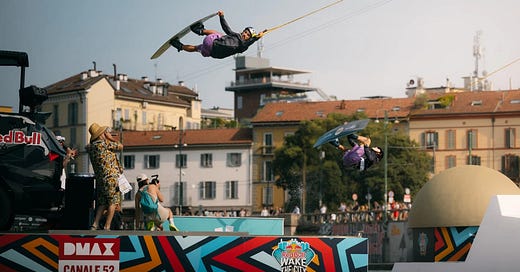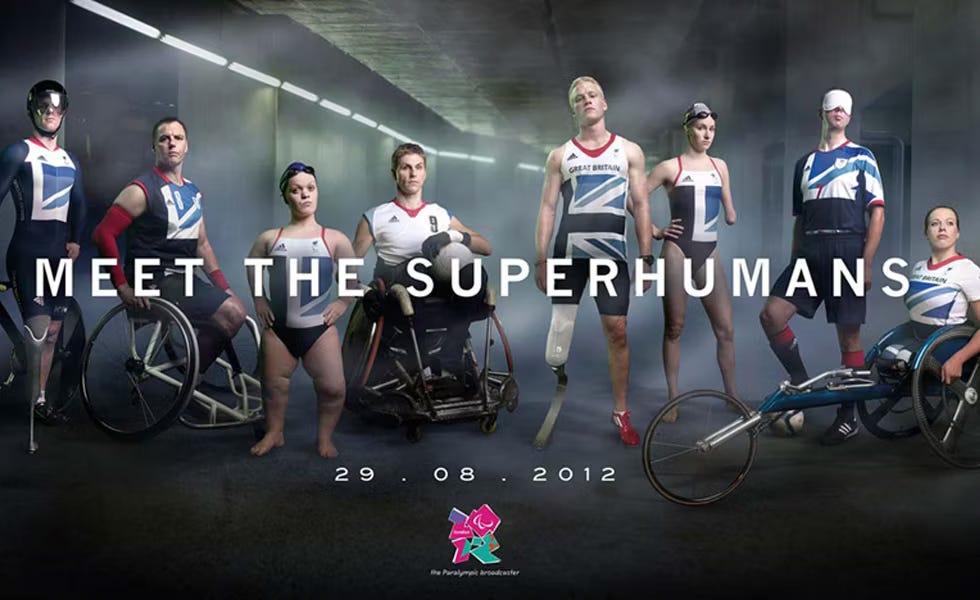The Paralympics follows the Olympics two weeks after the latter finishes. I’m not the numbers guy but it feels like it has about 1/16th the audience of the Olympics and 1/58th the hype.
And this is criminal. Because if you believe the Olympics are not just global sport’s crowning achievement, but the stage where the biggest drama takes place, the Paralympics offers — I submit — a more profound payoff.
You want to talk about Noah Lyles crossing the finish line a nose ahead of the silver medalist, you need to know about what it took gold medalist Jerusa Gerber dos Santos to get to the starting line in the first place.
The 12-day event is the ultimate showcase of human ingenuity over adversity. It reframes both familiar sports like basketball (in wheelchairs) and football (played with blindfolds), and adapts traditional Olympic sports to competitors with different bodies. Sprinters who are visually impaired run with Paralympic guides, both grasping either side of a tether, silent partners in a medal push. Archers lacking arms to pull their bowstrings, use teeth and feet instead, sometimes with age-defying results.
These are eye-opening events, as captivating for their innovative execution as for the intensity of the competition. And their appeal appears to be growing.
NBC, the International Olympic Committee’s US broadcast partner, aired only 6 hours of Paralympics coverage from the 2012 Games in London. In Paris, they reached 1,500 hours of streaming, via their Peacock streaming service. The company signed a record number of advertisers for those hours, a 60% bump from the previous games, according to a report in the Sports Business Journal. Toyota, AirBnB, and Bridgestone are all title sponsors. Bridgestone even did a little bit of content marketing around their innovative work with wheelchair athletes. But, boy, did they leave a lot on the floor.
Brands, generally, are going through a real thing with sports at the moment, focusing a lot of paid marketing at finding their place in a culture that produces obsessive fans, an always-on content cadence, and a consistently powerful narrative. But most are missing out on a more cost-efficient, organic strategy to align themselves with top performing athletes.
Entire media businesses have been built on an ability to tell a good sports story. Look at what Bill Simmons did first at Grantland, where he introduced the 30 for 30 Series at ESPN, and then in founding the successful podcast network The Ringer. Into the hegemony of ESPN in the U.S., streaming “upstarts” like Amazon are paying billions for the rights to broadcast sports.
Netflix is commissioning more series like Sprint and Simon Biles: Rising, to fill the years between the Olympics. Sports are one of the few forms of live entertainment to tidily encapsulate the hero’s journey in a few hours of watching. Some of the best recent examples of formats come from the sporting world (just look at what Formula 1: Drive to Survive did for prima donna race car drivers).
The content is rich and emotional, two adjectives brands should be keen to tap into. In Paralympic athletes, companies that position themselves around values like grit, craft, or innovation, have a trove of stories to tell and to enable. The way there involves betting on something before it gets big.
Red Bull 🪽 Now, they don’t sponsor a Paralympic athlete, but if they did they could tap into a well-oiled storytelling machine crafted over several decades around obscure sports. Since signing F1 pilot Gerhard Berger in 1989 as their first ever sponsored athlete, the energy drink brand has made it a practice to scour other “extreme”, more unknown sports for top performing athletes. The size of the sports playground often matters less than the brand’s ability to insert its “give you wiiings” narrative into it (my nine years there means I’m obligated to include the three “i”s). This is how the brand got in early with skateboarding and snowboarding, and continues to hold it down for random sports like wakeboarding and aerial acrobatics. Without new products to talk about beyond fizzy energy drinks, athletes and the storytelling around them become crucial to brand-building. Red Bull follows their lead in creating events and feats. Those feats — the most memorable being Felix Baumgartner’s skydive from the edge of space — position the brand as much more than a sponsor partner. The company finances the research, preparation, and product innovation that goes into massive projects like Red Bull Stratos, and owns the content strategy around it as well. And that strategy is rooted in two things: top-shelf production quality and emotional storytelling. Make the sport people have never heard of look incredible, and consistently hit upon themes — fear, failure, grit, triumph — that resonate with every human being. Why couldn’t a brand apply the same approach for Paralympic athletes? Not in the soft-focus, heartstring pulling sense, but in the power and innovation these competitors exhibit. The Paralympic athlete story is the ultimate story of innovating within constraints. What yawn-stifling tech brand wouldn’t instantly become more interesting by aligning themselves with that?
Channel 4 📹 The British broadcaster owns the rights to broadcast the Paralympics games and came out with an absolute banger of a trailer for their coverage way back in 2012, ahead of the London Games. It was a milestone for coverage of disability issues for Channel 4, founded in 1982 with a mandate to broadcast diversity and representation in Britain. Using an anthem by Public Enemy, “Superhumans” positioned Paralympic athletes as heroes engaged in some of the most grueling and taxing events in sports (“Forget everything you thought you knew about humans”). Twelve years on, I come back to this spot again and again — for its editing, its nuanced storytelling, but mostly because of the emotion that wells up within me and my desire to run through a brick wall for my dreams afterward. Following its debut, the Superhumans campaign became one of the most anticipated in the ad world every four years. For the 2016 Games in Rio, they used a jazz orchestra made up of adaptive musicians to provide the soundtrack (and star) in a trailer featuring athletes training in sports from football, to fencing, to swimming. In 2020, they paid off the line “To be a Paralympian, there’s got to be something wrong with you” with three minutes of athletes grinding out workouts, balancing life pressures and torturing themselves to get to to the Games. They went in a different direction for these Paralympics, adjusting the creative based on feedback from the adaptive athlete community. But their overall coverage only increased. Four’s popular humor show “The Last Leg” (hosted by Adam Hills, and his prosthetic leg) set up shop in Paris during the games, giving British Paralympic athletes the same heroes treatment Olympians get on the BBC after events. Scroll through 4’s IG handle, and the feed is dominated by highlights during the 12 days, like this one of a Nigerian high jump athlete who got into the sport less than a decade ago, and jumped over cars to attract sponsor interest. The investment is steady and long term and paying off: This year a record 18 million watched Channel 4’s coverage across its platforms over the 12 days of the games.





